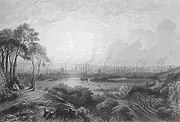Transport in Britain
At the beginning of the Industrial Revolution, inland transport was by navigable rivers and roads, with coastal vessels employed to move heavy goods by sea. Railways or wagon ways were used for conveying coal to rivers for further shipment, but canals had not yet been constructed. Animals supplied all of the motive power on land, with sails providing the motive power on the sea.
The Industrial Revolution improved Britain's transport infrastructure with a turnpike road network, a canal, and waterway network, and a railway network. Raw materials and finished products could be moved more quickly and cheaply than before. Improved transportation also allowed new ideas to spread quickly.
Coastal sail
Sailing vessels had long been used for moving goods round the British coast. The trade transporting coal to London from Newcastle had begun in mediaeval times. The major international seaports such as London, Bristol, and Liverpool, were the means by which raw materials such as cotton might be imported and finished goods exported. Transporting goods onwards within Britain by sea was common during the whole of the Industrial Revolution and only fell away with the growth of the railways at the end of the period.
Navigable rivers
- See also: List of rivers of United Kingdom
All the major rivers of the United Kingdom were navigable during the Industrial Revolution. Some were anciently navigable, notably the Severn, Thames, and Trent. Some were improved, or had navigation extended upstream, but usually in the period before the Industrial Revolution, rather than during it.
The Severn, in particular, was used for the movement of goods to the Midlands which had been imported into Bristol from abroad, and for the export of goods from centres of production in Shropshire (such as iron goods from Coalbrookdale) and the Black Country. Transport was by way of trows—small sailing vessels which could pass the various shallows and bridges in the river. The trows could navigate the Bristol Channel to the South Wales ports and Somerset ports, such as Bridgwater and even as far as France.
Canals
Canals began to be built in the late eighteenth century to link the major manufacturing centres in the Midlands and north with seaports and with London, at that time itself the largest manufacturing centre in the country. Canals were the first technology to allow bulk materials to be easily transported across country. A single canal horse could pull a load dozens of times larger than a cart at a faster pace. By the 1820s, a national network was in existence. Canal construction served as a model for the organisation and methods later used to construct the railways. They were eventually largely superseded as profitable commercial enterprises by the spread of the railways from the 1840s on.
Britain's canal network, together with its surviving mill buildings, is one of the most enduring features of the early Industrial Revolution to be seen in Britain.
Roads
Much of the original British road system was poorly maintained by thousands of local parishes, but from the 1720s (and occasionally earlier) turnpike trusts were set up to charge tolls and maintain some roads. Increasing numbers of main roads were turnpiked from the 1750s to the extent that almost every main road in England and Wales was the responsibility of some turnpike trust. New engineered roads were built by John Metcalf, Thomas Telford and John Macadam. The major turnpikes radiated from London and were the means by which the Royal Mail was able to reach the rest of the country. Heavy goods transport on these roads was by means of slow, broad wheeled, carts hauled by teams of horses. Lighter goods were conveyed by smaller carts or by teams of pack horse. Stage coaches carried the rich, and the less wealthy could pay to ride on carriers carts.
Railways
Wagonways for moving coal in the mining areas had started in the 17th century and were often associated with canal or river systems for the further movement of coal. These were all horse drawn or relied on gravity, with a stationary steam engine to haul the wagons back to the top of the incline. The first applications of the steam locomotive were on wagon or plate ways (as they were then often called from the cast iron plates used). Horse-drawn public railways did not begin until the early years of the 19th century. Steam-hauled public railways began with the Stockton and Darlington Railway in 1825 and the Liverpool and Manchester Railway in 1830. Construction of major railways connecting the larger cities and towns began in the 1830s but only gained momentum at the very end of the first Industrial Revolution.
After many of the workers had completed the railways, they did not return to their rural lifestyles but instead remained in the cities, providing additional workers for the factories.
Railways helped Britain's trade enormously, providing a quick and easy way of transport.
Social effects
In terms of social structure, the Industrial Revolution witnessed the triumph of a middle class of industrialists and businessmen over a landed class of nobility and gentry.
Ordinary working people found increased opportunities for employment in the new mills and factories, but these were often under strict working conditions with long hours of labour dominated by a pace set by machines. However, harsh working conditions were prevalent long before the Industrial Revolution took place. Pre-industrial society was very static and often cruel—child labour, dirty living conditions and long working hours were just as prevalent before the Industrial Revolution.[32]
Factories and urbanisation
Industrialisation led to the creation of the factory. Arguably the first was John Lombe's water-powered silk mill at Derby, operational by 1721. However, the rise of the factory came somewhat later when cotton spinning was mechanised.
The factory system was largely responsible for the rise of the modern city, as large numbers of workers migrated into the cities in search of employment in the factories. Nowhere was this better illustrated than the mills and associated industries of Manchester, nicknamed "Cottonopolis", and arguably the world's first industrial city. For much of the 19th century, production was done in small mills, which were typically water-powered and built to serve local needs. Later each factory would have its own steam engine and a chimney to give an efficient draft through its boiler.
The transition to industrialisation was not without difficulty. For example, a group of English workers known as Luddites formed to protest against industrialisation and sometimes sabotaged factories.
In other industries the transition to factory production was not so divisive. Some industrialists themselves tried to improve factory and living conditions for their workers. One of the earliest such reformers was Robert Owen, known for his pioneering efforts in improving conditions for workers at the New Lanark mills, and often regarded as one of the key thinkers of the early socialist movement.
By 1746, an integrated brass mill was working at Warmley near Bristol. Raw material went in at one end, was smelted into brass and was turned into pans, pins, wire, and other goods. Housing was provided for workers on site. Josiah Wedgwood and Matthew Boulton were other prominent early industrialists, who employed the factory system.
Child labour
The Industrial Revolution led to a population increase, but the chance of surviving childhood did not improve throughout the industrial revolution (although infant mortality rates were reduced markedly).[33][34] There was still limited opportunity for education, and children were expected to work. Employers could pay a child less than an adult even though their productivity was comparable; there was no need for strength to operate an industrial machine, and since the industrial system was completely new there were no experienced adult labourers. This made child labour the labour of choice for manufacturing in the early phases of the Industrial Revolution between the 18th and 19th centuries.
Child labour had existed before the Industrial Revolution, but with the increase in population and education it became more visible. Before the passing of laws protecting children, many were forced to work in terrible conditions for much lower pay than their elders.[35]
Reports were written detailing some of the abuses, particularly in the coal mines[36] and textile factories[37] and these helped to popularise the children's plight. The public outcry, especially among the upper and middle classes, helped stir change in the young workers' welfare.
Politicians and the government tried to limit child labour by law, but factory owners resisted; some felt that they were aiding the poor by giving their children money to buy food to avoid starvation, and others simply welcomed the cheap labour. In 1833 and 1844, the first general laws against child labour, the Factory Acts, were passed in England: Children younger than nine were not allowed to work, children were not permitted to work at night, and the work day of youth under the age of 18 was limited to twelve hours. Factory inspectors supervised the execution of the law. About ten years later, the employment of children and women in mining was forbidden. These laws decreased the number of child labourers; however, child labour remained in Europe up to the 20th century.[citation needed]
Housing

Over London by Rail Gustave Doré c. 1870. Shows the densely populated and polluted environments created in the new industrial cities
Living conditions during the Industrial Revolution varied from the splendour of the homes of the owners to the squalor of the lives of the workers. Cliffe Castle, Keighley, is a good example of how the newly rich chose to live. This is a large home modelled loosely on a castle with towers and garden walls. The home is very large and was surrounded by a massive garden, the Cliffe Castle is now open to the public as a museum.
Poor people lived in very small houses in cramped streets. These homes would share toilet facilities, have open sewers and would be at risk of damp. Disease was spread through a contaminated water supply. Conditions did improve during the 19th century as public health acts were introduced covering things such as sewage, hygiene and making some boundaries upon the construction of homes. Not everybody lived in homes like these. The Industrial Revolution created a larger middle class of professionals such as lawyers and doctors. The conditions for the poor improved over the course of the 19th century because of government and local plans which led to cities becoming cleaner places, but life had not been easy for the poor before industrialisation. However, as a result of the Revolution, huge numbers of the working class died due to diseases spreading through the cramped living conditions. Chest diseases from the mines, cholera from polluted water and typhoid were also extremely common, as was smallpox. Accidents in factories with child and female workers were regular. Dickens' novels illustrate this; even some government officials were horrified by what they saw[citation needed]. Strikes and riots by workers were also relatively common.









0 komentar on "Transport in Britain during the Industrial Revolution"
Post a Comment